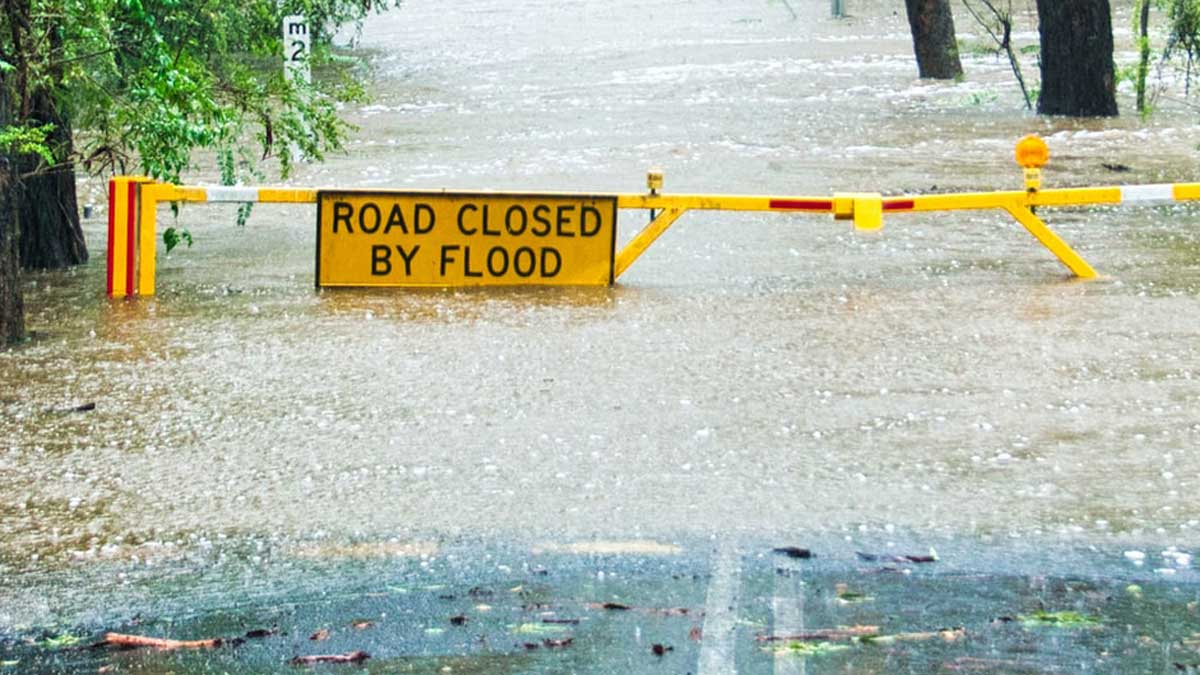What Is A Flash Flood? Understanding Flood Warnings And Alerts

Table of Contents
What Causes a Flash Flood?
Several factors contribute to the formation of flash floods. Understanding these causes is the first step in effective preparedness.
Intense Rainfall
The most common cause of flash floods is intense rainfall over a short period. This overwhelming deluge surpasses the capacity of drainage systems, leading to rapid water accumulation and overflowing waterways.
- Weather Systems: Thunderstorms, particularly those associated with slow-moving weather fronts or training thunderstorms (where multiple storms repeatedly pass over the same area), are major culprits. Monsoons in certain regions also significantly increase the risk of flash flooding.
- Soil Saturation and Impermeable Surfaces: Already saturated ground from prior rainfall or snowmelt cannot absorb additional water, leading to increased surface runoff. Impermeable surfaces like paved roads and parking lots further exacerbate this problem, channeling water directly into storm drains, which can quickly overflow.
Geographical Factors
The topography of an area significantly influences its vulnerability to flash floods.
- Steep Slopes and Narrow Canyons: Steep slopes accelerate the flow of water downhill, rapidly concentrating it in low-lying areas. Narrow canyons channel the water, creating powerful and destructive currents.
- Urban Areas: Urban areas with limited green space and extensive paved surfaces are particularly prone to flash floods due to increased runoff and reduced infiltration. Dam failures or levee breaches can also trigger catastrophic flash floods downstream.
Human Activities
Human actions can significantly worsen the risk of flash floods.
- Deforestation and Urban Development: Removing trees and vegetation reduces the land's capacity to absorb rainfall, increasing surface runoff. Urban development often replaces natural drainage systems with impervious surfaces, further exacerbating the problem.
- Improper Land Management: Poor land management practices, such as inadequate drainage systems or construction in floodplains, can significantly increase the risk of flash floods.
Recognizing Flash Flood Warnings and Alerts
Understanding the different types of alerts and how to interpret flood forecasts is paramount to staying safe.
Different Types of Warnings
- Flash Flood Watch: Conditions are favorable for flash flooding. Stay informed and be prepared to act.
- Flash Flood Warning: Flash flooding is occurring or is imminent. Take immediate action to protect yourself and your property.
- Flash Flood Advisory: Flash flooding is possible. Be aware of the potential danger and monitor the situation closely.
These warnings are disseminated through various channels, including weather radio, mobile emergency alerts (like Wireless Emergency Alerts or WEA), local news, and weather websites.
Interpreting Flood Forecasts
Flood forecasts provide valuable insights into the potential impact of a flood event.
- Flood Maps: Flood maps illustrate areas at risk of flooding. Familiarize yourself with the flood map for your area.
- Flood Stage Information: This indicates the water level at which flooding becomes imminent. Understanding the flood stage for your local waterways is critical.
- Reliable Sources: The National Weather Service (or your country's equivalent) is the most reliable source for flood information.
Using Technology for Alerts
Leverage technology to stay informed.
- Weather Apps: Numerous weather apps provide real-time alerts and forecasts, including flash flood warnings.
- Weather Websites: Reputable weather websites offer detailed flood information, forecasts, and radar imagery.
- Multiple Sources: Always use multiple sources to ensure you have the most accurate and up-to-date information.
Staying Safe During a Flash Flood
Your actions during a flash flood can mean the difference between life and death.
Evacuation Procedures
- Evacuate When Instructed: Heed evacuation orders immediately. Do not delay.
- Evacuation Plan: Develop a family evacuation plan in advance, including designated meeting points and escape routes.
- Essential Items: Prepare a "go-bag" with essential items like medications, important documents, and water.
Safety Measures
- Avoid Floodwaters: Never drive or walk through floodwaters. The depth and current may be stronger than you think, and hidden dangers lurk beneath the surface.
- Move to Higher Ground: Seek higher ground immediately if a flash flood occurs.
- Avoid Streams and Rivers: Never attempt to cross a flowing stream or river during or after a flash flood.
Post-Flood Safety
Even after the floodwaters recede, dangers remain.
- Downed Power Lines: Avoid downed power lines – they may be energized.
- Contaminated Water: Floodwaters are often contaminated with sewage and other pollutants. Avoid contact.
- Report Damage: Report any damage to your local authorities and seek assistance as needed.
Conclusion: Preparing for and Protecting Yourself from Flash Floods
Flash floods are dangerous and unpredictable events. Understanding their causes, recognizing warnings, and taking appropriate safety measures are vital for minimizing the risk. Remember to always heed flash flood warnings, develop a personal safety plan, and familiarize yourself with your local flood risks. Take action today to improve your flash flood preparedness. Research your local flood risks, sign up for emergency alerts, and learn more about flash flood safety in your community. Prioritize flash flood preparedness to protect your life and property.

Featured Posts
-
 Post Night Out Annie Kilner Runs Errands Amidst Husbands Controversy
May 25, 2025
Post Night Out Annie Kilner Runs Errands Amidst Husbands Controversy
May 25, 2025 -
 Significant Delays On M6 Southbound Following Accident
May 25, 2025
Significant Delays On M6 Southbound Following Accident
May 25, 2025 -
 From Grace To Disaster 17 Celebrities Whose Reputations Imploded
May 25, 2025
From Grace To Disaster 17 Celebrities Whose Reputations Imploded
May 25, 2025 -
 Gauff Defeats Zheng In Italian Open Semifinal
May 25, 2025
Gauff Defeats Zheng In Italian Open Semifinal
May 25, 2025 -
 French Lawmakers Push For Dreyfus Posthumous Promotion A Symbolic Gesture Of Justice
May 25, 2025
French Lawmakers Push For Dreyfus Posthumous Promotion A Symbolic Gesture Of Justice
May 25, 2025
Latest Posts
-
 Mercedes I Allagi Stratigikis Gia Tin Epomeni Sezon Tis F1
May 25, 2025
Mercedes I Allagi Stratigikis Gia Tin Epomeni Sezon Tis F1
May 25, 2025 -
 O Verstappen Den Einai Pleon Proteraiotita Gia Ti Mercedes
May 25, 2025
O Verstappen Den Einai Pleon Proteraiotita Gia Ti Mercedes
May 25, 2025 -
 Rising Tennis Culture In China Impact Of Top International Players
May 25, 2025
Rising Tennis Culture In China Impact Of Top International Players
May 25, 2025 -
 I Mercedes Kai I Pithanotita Apoktisis Toy Verstappen
May 25, 2025
I Mercedes Kai I Pithanotita Apoktisis Toy Verstappen
May 25, 2025 -
 Chinas Tennis Culture Boosted By Top Players Italian Open Director
May 25, 2025
Chinas Tennis Culture Boosted By Top Players Italian Open Director
May 25, 2025
